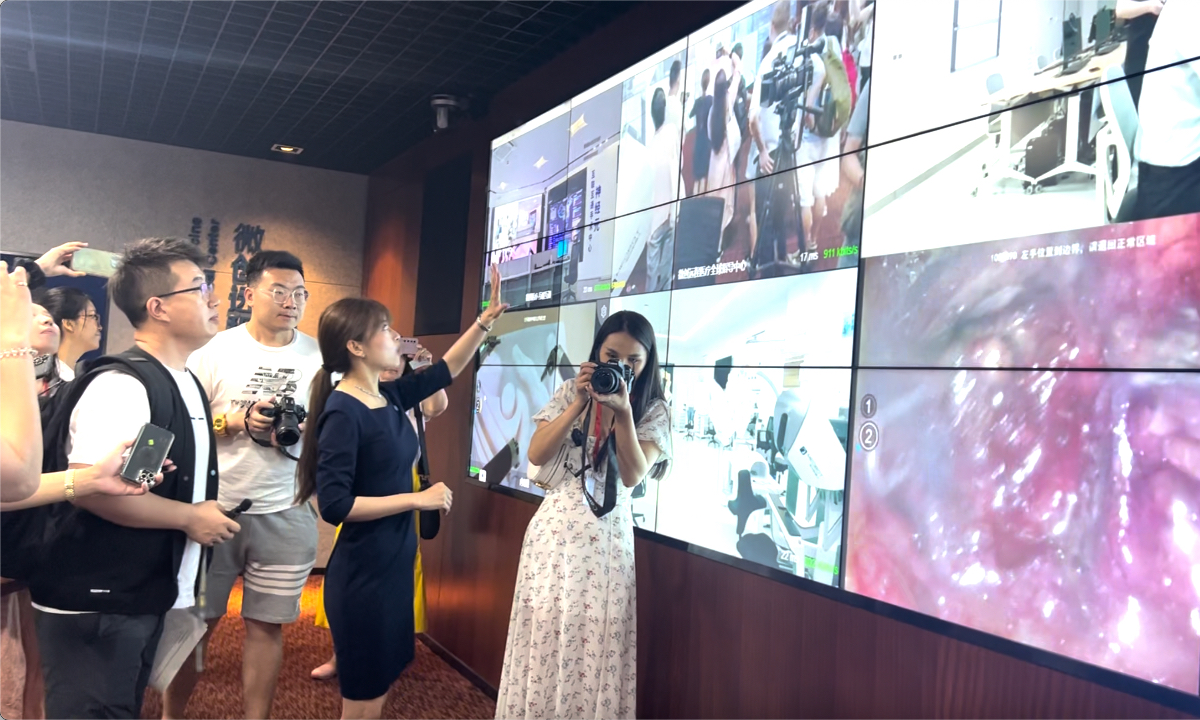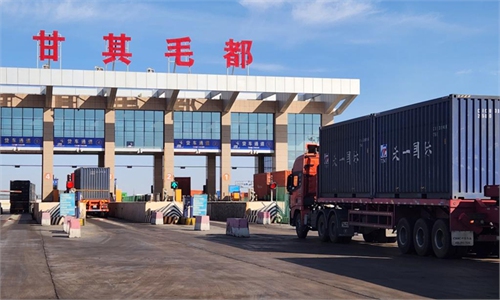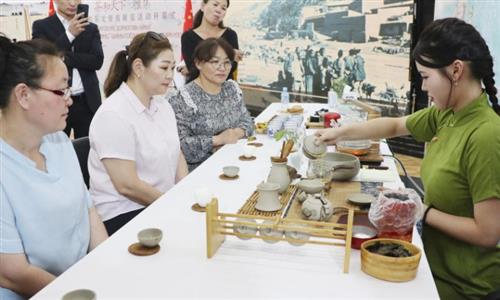
Mongolian journalists visit medical device developer MicroPort Scientific Corporation in Shanghai on June 26, 2023. Photo: Du Qiongfang/GT
5G, AI, remote-control, robots and laparoscopic surgery, a series of cutting-edge concepts and terms combined baffled interpreters but fascinated a group of experienced and knowledgeable journalists during an ongoing joint interview event in Shanghai hosted by journalism associations from Mongolia and China.
At their first stop on their trip on Monday at the MicroPort Scientific Corporation, advanced medical devices and equipment independently researched and developed by the Chinese company impressed the journalists from both countries.
One of the company’s most impressive breakthroughs is a 5G remote-control surgical robot that can conduct laparoscopic (minimally invasive) surgeries on a patient ranging from chest, abdomen to pelvis with the operating surgeon located thousands of miles away.
A recent ultra-long-range surgery completed successfully by the robot named Toumai was a challenging hepatectomy surgery conducted on a patient in Northwest China’s Xinjiang Uygur Autonomous Region by a surgeon operating in Hangzhou, East China’s Zhejiang Province, around 5,000 kilometers away from each other. The surgery was the first of its kind and represents a new milestone for hepatobiliary surgery in China.
Wearing a set of sophisticated sensors, the surgeon controlled the scalpel in conducting the surgery by observing live footage through a monitor. The procedure was a highly sophiscated surgery that required precise techniques to assure surgical safety.
However, such a minimally invasive surgery conducted by highly skilled and experienced surgeons in third-tier (highest level) hospitals in Chinese cities like Beijing, Shanghai and Hangzhou are now available to patients in less developed areas where medical resources are insufficient, with the help of the remote-control surgery robot.
According to the company, before Toumai was developed, similar minimally invasive surgeries conducted by a surgery robot with a wide range of functions, higher success rate and lower risk of postoperative complications had been monopolized by foreign products for over 20 years in China.
When the company’s representative said that this Chinese surgery robot can one day be used in Mongolia to provide the same high-level medical services, the Mongolian visitors broke into rapturous applause.
Many Mongolian journalists were interested in the price of the robot, the number of operations it had performed, and how long the Mongolian hospitals need to wait if they want to purchase the robot, showing great interest in reporting on this machine to their readers and audience back home.
Lu Zhuoqun, a PR specialist from the company, said the surgery robot, priced at less than 20 million yuan ($2.77 million), has performed over 1,000 surgeries across more than 30 hospitals in 17 Chinese provinces since it hit the market in January 2022.
“It is amazing that the surgery can be conducted by a robot and I believe this equipment will greatly improve the standard of medical service in Mongolia if they are introduced into our country which faces a heavy burden in delivering healthcare,” Gerelee, a journalist from Mongolian news portal see.mn told the Global Times on Monday.
“It meant a lot to me have the opportunity to visit this kind of medical device company and I will report what I have seen here to the public when I go back to my country, and hope that it is possible to cooperate between Mongolian hospitals and the company in the future to improve the well-being of people in my country,” another Mongolian reporter said.
Founded in 1998, a long time before the concept of minimally invasive surgery became mainstream, the company has developed into a world-leading high-end medical device R&D and manufacturing provider, with over 500 registered products used in over 20,000 hospitals across the world.
Apart from creating the first domestically developed quadruple-arm endoscopic surgery robot, the company has also developed different kinds of surgery robots applied to a wide range of use cases involving orthopedic surgery, vascular intervention surgery, prostate biopsies guidance and 3D electronic laparoscopes.
Headquartered in Shanghai, the company has subsidiaries or R&D centers in other Chinese cities such as Suzhou, Jiaxing and Dongguan, as well as overseas countries and regions including France, Brazil and North America.
According to Lu, it usually takes eight years to develop a medical device whereas the average service lifespan of a medical device only lasts five years. Despite the company facing challenges brought by the cost and difficulty of R&D, it has developed over 500 products in only 25 years, which the firm attribute to their commitment to scientific and technological innovation.
Jointly hosted by the All-China Journalists Association and the Mongolian Association of Journalists, the joint interview event, which was themed “Meeting China, Meeting the New Era” involving over 40 reporters from over 20 mainstream and state-owned media outlets from Mongolia and China kicked off in Hohhot city in North China’s Inner Mongolia Autonomous Region on Sunday evening and will run through this week. Outside of Shanghai, the group of reporters from both countries will visit cities including Suzhou, Nantong, Qidong and Nanjing in East China’s Jiangsu Province.
As the first stop in the joint interview event, Shanghai showcased Chinese-style modernization in terms of high-quality development, scientific and technological innovation, environmental protection and urban governance.


